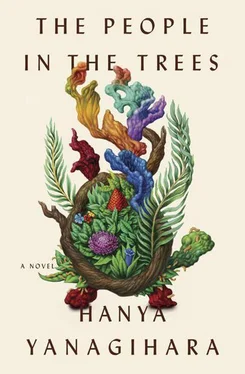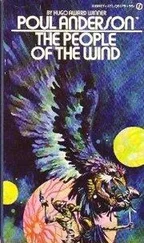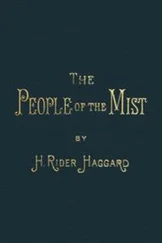One day during the spring of Victor’s sophomore year of college, I was sitting at home in the garden. It was a beautiful, damp day, the kind of early-spring day in which everything becomes, as if at once, a hundred unnameable shades of startling green, and I was gazing at the trees, their new leaves so tender and young and light that they were as translucent and resplendent as if fashioned from thin sheets of gold. I had come home early from work because I had been suffering from an intestinal flu, and my head felt cottony, my saliva tangy with bile. But I remember feeling grateful to be at home and in my garden, with the world quiet around me.
I was in such a state of enchantment that I did not even hear the knocking on the door, did not hear the doorbell’s insistent chime. So when the two men came through the back door to the garden, I was surprised, and quickly stood. One was black and one was white, one older, one younger. “Who are you?” I asked them.
The young white one answered me with a question. “Abraham Norton Perina?”
What could I do? I nodded.
“Detective Matthew Banville, Montgomery County Police Department,” said the man, and coughed, as if embarrassed. “I’m afraid, Dr. Perina, we have some questions we need to ask you down at the station.”
Above me a butterfly, the first of the season, had suddenly appeared, flapping its clean white wings near my face in such a frenzy that I thought for a moment it was trying to beat out a warning, a message only I would be able to understand.
But there was nothing. And when I turned back to the men, they were still there, waiting for me silently, their faces stern and blank and dispassionate — not the kind of faces I was used to seeing at all.
“I need to get my pills,” I was finally able to say, and Detective Banville looked at the other, who nodded, and the three of us walked into the house together. They let me go into the bathroom by myself, and I stood in front of the mirror for a long moment, staring at my face and wondering what was going to happen to me. I realized then that I had not asked them on what grounds I was going to be questioned. I have done nothing , I told my reflection, which stared back at me blandly. I will ask them why they are here , I thought, and it will be nothing and this will be over and it will be as if it had never happened . So I did go out to ask them, but as you know, it was not nothing, I was not let go, and my life, as it was, was forever changed. And had I known then how profoundly difficult things were soon to become, I think I would have endeavored to remain in the bathroom for much longer, staring at my face as if for answers, while outside the men waited, and the earth twirled lazily on.
77Actually a twenty-two-year-old man who was enrolled in graduate school at Syracuse University.
78In the lab, of course. There is invariably a gourmand — or, if one is being less charitable, a budding alcoholic — among the staff of any lab who spends his leisure time developing various liquors in the beakers and decanting them at impromptu office parties. Some of these brews are actually quite respectable.
79Much of Norton’s work throughout the 1980s concentrated on the Karée people, a small tribe (its total population was less than six hundred) who live in northern Brazil off a particularly narrow and treacherous Amazonian tributary. The Karée were encountered in 1978 by a botanist from the University of California, Santa Cruz, named Lucien Feeney, who stumbled on their society by accident while searching for a rare fern ( Microsorum coccinella ) that he speculated was an early cousin of the modern palm tree and that had been harvested to near extinction throughout the rest of the basin some two hundred years prior. When he observed the tribe, Feeney knew that there was something strange about them, but he was unable to determine what, exactly, made them unique. Upon his return to Santa Cruz, he contacted Norton through an acquaintance at Johns Hopkins, and Norton made his first visit to the tribe shortly thereafter (I accompanied him on this trip as well as subsequent ones). Tests and other fieldwork revealed that the Karée experienced an unusually delayed adolescence; indeed, neither boys nor girls displayed any signs of secondary sex organs until, on average, the age of twenty-five. The puberty that followed was an intense and brutal eighteen-month ordeal that culminated in marriage. After, their biological lives proceeded as normal, which meant that the women had a relatively brief two decades of fertility before undergoing menopause. As a result, there was a great urgency to have as many children as possible, and many of the Karée women died as a result of excessive pregnancies and collectively experienced a remarkably high rate of gynecological complications.
In an echo of the Opa’ivu’eke people, the cause of this abnormality was originally attributed to an endemic rodent ( Hydrochoerus feenius ) that all Karée children grow up eating (it was favored for its succulent, sweetish meat). This was of course highly exciting, especially given Norton’s earlier groundbreaking work, but later studies revealed that the culprit was not in fact an external element but something specific to the Karée’s biology. Nevertheless, Norton tried to bring back a number of the Karée to his lab for further study but was prevented from doing so by the National Commission for the Protection of Human Subjects of Biomedical and Behavioral Research, which had kept him under unnaturally strict surveillance ever since he had appealed the removal of the dreamers in 1976. Various political struggles forced Norton to abort his work with the Karée in 1990, and today it is Harvard University that maintains a satellite lab — and therefore controls which scientists might be granted access — on the tribe’s land. Norton, understandably, remains bitter about how these events unfolded, which is probably why he fails to mention his work with the Karée in this account. Those interested can find an evenhanded rendering of the situation in Anna Kidd’s excellent Of Stone and Sun and Everything In-Between .
80Sonia Alice Perina, arrived 1970. She now goes by the name SoAP and is a performance poet and artist of some renown in New York.
81Norton had named previous children Owen. There was Owen Ambrose (arrived ca. 1969), Owen Edmund (arrived ca. 1969), and Richard Owen (arrived ca. 1971). By 1986 or so, around which time Norton was busy adopting what was to be his final generation of children, Owen had become the de facto middle name regardless of gender: I clearly remember, besides Victor, a Giselle Owen, a Percy Owen (there was also a Percival Owen in an earlier generation), a Drew Owen, a Jared Owen, and a Grace Owen. Whether this was a result of Norton’s forgetfulness or distraction or was in fact a sort of homage to his brother was never clear.
82There is a section following this that I have, as an editor, elected to excise.
Now begins a very upsetting and difficult time of my life, on which I would rather not (but suppose, in the interest of honesty, must) dwell, if only briefly.
I have to admit that I remember very little of the initial interrogation and rather less of the arrest, which is strange, for I recall feeling extraordinarily alert and almost painfully engaged in the activity at hand (which was, unfortunately, a recounting of the events leading to my undoing). I remember looking about me at the colors and shapes sharpening and deepening in tone and line before my eyes, and finding the world oppressive, with its needlessly aggressive colors and strange objects and harsh, jangling sounds. Sometimes I would have to take my glasses off simply so the world would smudge and recede for a moment and cease to seem so relentlessly present tense. In particular, I remember waiting in an interrogation room at the police station, and even in the blandness of that space — the dreary, dimpled sea-gray brick walls, the stone-gray floors, the gray aluminum table with its silvery filaments like threads in silk — I felt attacked, as if the gray itself might gather into a great wave and drown me under its weight.
Читать дальше












